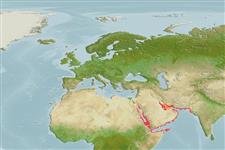Environment: milieu / climate zone / depth range / distribution range
Ekologi
laut berasosiasi dengan karang; kisaran kedalaman 5 - 50 m (Ref. 89707). Tropical; 29°N - 10°N, 32°E - 68°E (Ref. 5222)
Western Indian Ocean: Red Sea (including Gulf of Suez) and northwestern Indian Ocean to the coast of Pakistan. Specimens examined include those from the Gulf of Oman. Not reported from the Gulf of Aqaba nor from Persian Gulf.
Size / Weight / umur
Maturity: Lm ? range ? - ? cm
Max length : 38.0 cm TL jantan/; (Ref. 89707); common length : 35.0 cm TL jantan/; (Ref. 5450)
Duri punggung (Keseluruhan (total)) : 11; duri punggung lunak (Keseluruhan (total)) : 16 - 18; Duri dubur: 3; Sirip dubur lunak: 8. Body robust, preopercle with moderately enlarged serrae at its angle; upper edge of the operculum almost straight; nostrils subequal or posterior nostril slightly larger. Head and body yellowish gray, with dark orange-red or reddish brown spots except ventrally and posteriorly; dark gray bars running antero-ventrally from the base of the dorsal fin; a dark saddle blotch on the caudal peduncle. Fins generally yellowish brown; median fins with broad yellowish margin posteriorly (Ref. 89707).
Occurs on shallow sandy bottoms near small coral heads; it is not known from well-developed coral reefs (Ref. 5222). Nothing has been published on its biology nor its use in fisheries (Ref. 5222). Sold fresh in local markets (Ref. 5222).
Life cycle and mating behavior
Maturities | Reproduksi, perkembang biakan | Spawnings | Egg(s) | Fecundities | Larva
Heemstra, P.C. and J.E. Randall, 1993. FAO Species Catalogue. Vol. 16. Groupers of the world (family Serranidae, subfamily Epinephelinae). An annotated and illustrated catalogue of the grouper, rockcod, hind, coral grouper and lyretail species known to date. Rome: FAO. FAO Fish. Synop. 125(16):382 p. (Ref. 5222)
Status IUCN Red List (Ref. 130435)
ancaman kepada manusia
Harmless
penggunaan manusia
Perikanan: nilai komersial kecil
Alat, peralatan
laporan khas
muat turun XML
Sumber internet
Estimates based on models
Preferred temperature (Ref.
123201): 25.4 - 29.4, mean 27.9 °C (based on 142 cells).
Phylogenetic diversity index (Ref.
82804): PD
50 = 0.5000 [Uniqueness, from 0.5 = low to 2.0 = high].
Bayesian length-weight: a=0.01175 (0.00571 - 0.02419), b=3.04 (2.88 - 3.20), in cm total length, based on LWR estimates for this Genus-body shape (Ref.
93245).
Trophic level (Ref.
69278): 3.7 ±0.6 se; based on size and trophs of closest relatives
Daya lenting (Ref.
120179): sedang, Waktu penggandaan populasi minimum 1.4 - 4.4 tahun (Preliminary K or Fecundity.).
Fishing Vulnerability (Ref.
59153): Low to moderate vulnerability (28 of 100).
Nutrients (Ref.
124155): Calcium = 34.4 [17.0, 70.1] mg/100g; Iron = 0.515 [0.282, 1.054] mg/100g; Protein = 18.5 [17.0, 19.9] %; Omega3 = 0.128 [0.082, 0.201] g/100g; Selenium = 30.8 [18.6, 53.3] μg/100g; VitaminA = 217 [61, 775] μg/100g; Zinc = 1.39 [0.96, 1.94] mg/100g (wet weight);
